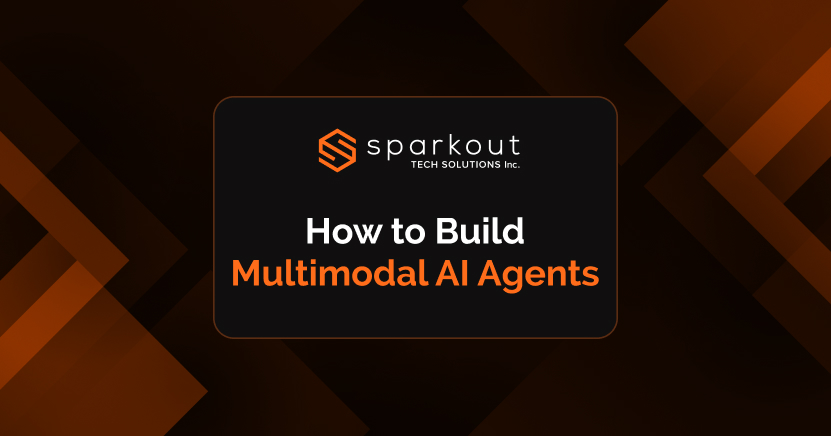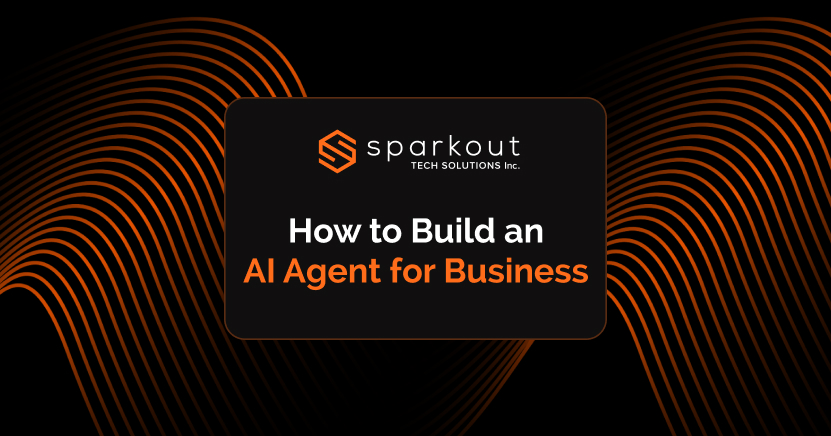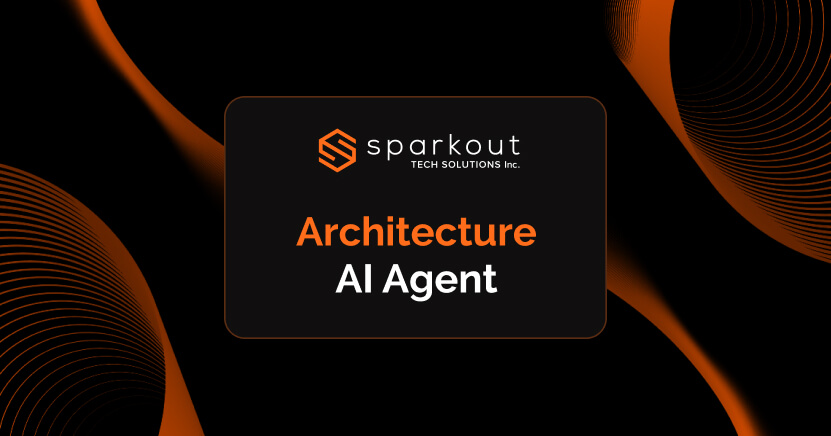Artificial Intelligence (AI) is becoming the most in-demand and strategic technology across industries in 2026. From intelligent chatbots and recommendation engines to fraud detection systems and enterprise AI software, the adoption of AI-powered solutions is increasing rapidly. Although it's in high demand, understanding the cost of AI software development has become a critical consideration. With AI adoption gaining popularity, companies must understand what drives development costs to plan effectively and stay competitive.
As per statistics, global AI software revenue is estimated to reach $150 billion by the end of 2026, with a breakthrough in generative AI, NLP, and computer vision. Despite this growth, developing AI solutions remains not only complex but also a costly process and making it quintessential to break down expenses clearly.
Whether you are building a small AI-powered mobile app or deploying a large-scale enterprise AI system, knowing the real AI development cost helps companies ensure smarter investment and long-term ROI.
In this blog, you will discover a comprehensive pricing guide covering an average AI development cost, influencing factors, project timelines, team structures, and ROI strategies. By evaluating the AI implementation cost in detail, you can better handle the budget constraints and rising expectations, setting your AI initiative up for success.
Average AI Software Development Cost in 2026
When it comes to AI software development, there is no one-size-fits-all pricing model. i.e., the cost changes significantly based on the project's complexity, tech stack, development team composition, and business goals. Check out the estimated AI software price based on the different type of AI agents:
Custom AI Software Pricing by Project Type
| AI Project Type | Estimated Cost (USD) | Timeline |
|---|---|---|
| Simple AI Chatbot (NLP-based) | $15,000 – $40,000 | 1–2 months |
| Predictive Analytics Dashboard | $40,000 – $100,000 | 2–4 months |
| Computer Vision Application | $80,000 – $150,000 | 3–6 months |
| AI-powered SaaS Platform | $100,000 – $500,000+ | 4–8 months |
| Custom Enterprise AI Software | $250,000 – $1,000,000+ | 6–12 months |
These estimation covers end-to-end development, starting from ideation and design to deployment and initial maintenance.
How Much Does AI Development Cost for Small Businesses in 2026
Unlike large businesses and enterprises, small businesses and startups don’t need massive budget to get started with AI. It actually depends on what you’re building and the level of automation you need.
| AI Solution Type | What It Includes | Estimated Cost (USD) |
|---|---|---|
| AI Chatbot (Base) | Pre-built models, generic workflows, and web integration | $1,500 – $8,000 |
| AI Customer Support Assistance | NLP, ticket handling, CRM integration | $5,000 – $20,000 |
| AI Lead Generation | Automation, Prospect scoring, and outreach personalization | $7,000 – 25,000 |
| AI Recommendation Engines | Product suggestion, user behaviour, and basic tracking | $8,000 – $30,000 |
| AI Analytics & Forecasting Tools | Demand prediction, financial forecasting, and dashboards | $10,000 – $40,000 |
| Custom AI Model for Operations | Workflow automation, tailored models, and training data setup | $20,000 – $100,000+ |
| AI Integration for Existing Software | API setups, data mapping, and automation flows | $3,000 – $15,000 |
| End-to-End AI App | UI+ backend + model integration | $30,000 – $150,000+ |
These estimation covers end-to-end development, starting from ideation and design to deployment and initial maintenance.
Cost Breakdown by Development Phase
The table below gives an overview of organizations planning to invest in AI solutions. Take a look at the budget overview across different development stages.
| Development Phase | Estimated Cost Range (USD) | % of Total Cost | What’s Included |
|---|---|---|---|
| 1. Data Collection & Preprocessing | $10,000 – $100,000 | 10% – 20% | Data gathering, labeling, cleaning, and preparing datasets for training. |
| 2. Model Training & Tuning | $20,000 – $150,000 | 20% – 30% | Building, training, and fine-tuning ML/LLM models (includes compute costs). |
| 3. System Integration | $15,000 – $80,000 | 15% – 25% | Connecting the AI model with APIs, databases, CRM/ERP systems, and third-party tools. |
| 4. UI/UX Development | $10,000 – $60,000 | 10% – 15% | Creating user-friendly interfaces, dashboards, and front-end interactions. |
| 5. Testing & Quality Assurance | $5,000 – $30,000 | 5% – 10% | Ensuring functionality, model performance, and security compliance. |
| 6. Deployment & DevOps | $5,000 – $25,000 | 5% – 8% | Setting up CI/CD pipelines, cloud infra, and containerization (e.g., Docker, Kubernetes). |
| 7. Post-launch Support & Maintenance | $10,000 – $50,000+ (annually) | 10%+ (ongoing) | Model monitoring, updates, bug fixes, performance tuning, and retraining. |
Key Factors Influencing AI Software Development Cost
Besides the question how much does AI development costs lies several critical factors influence the overall AI software development cost. It is vital to understand these factors to make informed decisions, manage your budget, and prioritize investments effectively.
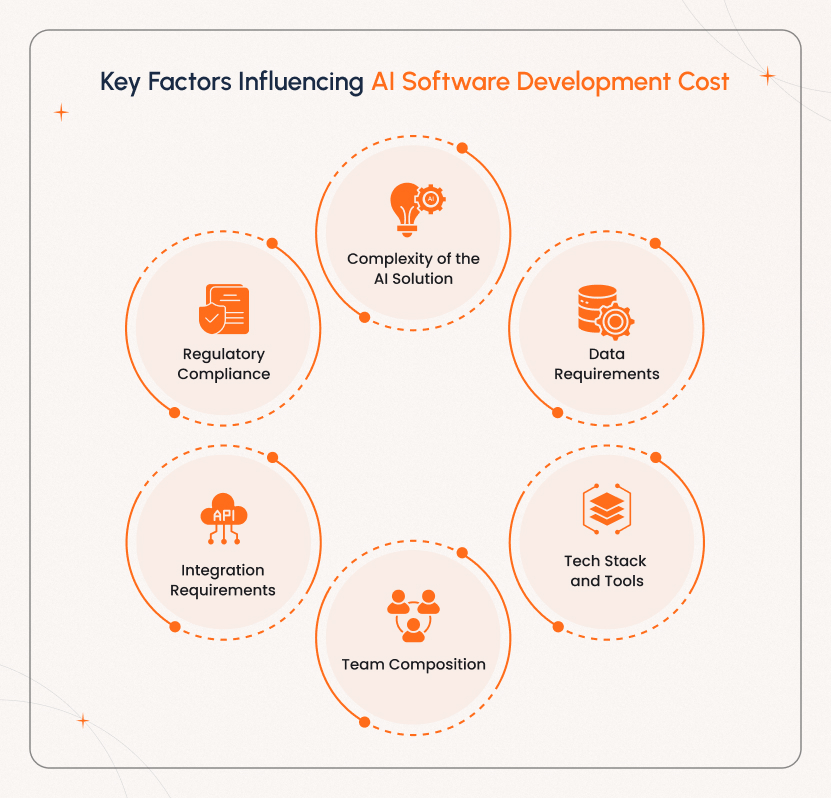
Here is the breakdown of the top factors affecting AI software cost in 2026:
The AI development cost depends heavily on whether you are using pre-trained models like OpenAI, Claude, or Mistral, or building a custom machine learning model from scratch.
Using pre-trained models reduces costs while speeding up deployment. In contrast, custom AI models involve higher complexity, require more development hours, infrastructure, and tuning, thus driving up the machine learning software cost.
Selecting the right model is key to optimizing your AI development cost breakdown.
Data is the backbone of any AI system and accounts for up to 40% of your AI software cost. It is vital to budget for data collection, cleaning, and annotation.
The expense may increase for larger, domain-specific models, as they require curated datasets.
The choice of tools not only impacts the cost to build AI software but also its scalability. Frameworks like PyTorch, TensorFlow, or cloud platforms like Vertex AI come with different pricing models.
One of the key factors influencing the development cost of AI software is the team behind the build. Hiring an in-house team can be expensive due to salaries, infrastructure, and overheads. In contrast, opting for AI development outsourcing significantly lowers the AI engineer cost while still providing access to experts.
Integrating your AI system with existing infrastructure like CRMs, APIs, IoT devices, or enterprise platforms adds complexity. The deeper the integration, the higher the AI app development cost, as this involves testing and compatibility layers.
It is vital for industries like healthcare and finance to follow strict laws like HIPAA and GDPR. Implementing audit trails, security, and data privacy features may raise your AI development cost breakdown. It is important to note that this is an essential factor for legal and ethical deployment.
Discover the key cost factors that impact your AI build — and learn how to optimize every dollar with expert insight.
Hidden & Ongoing Costs in AI Software Development You Shouldn't Ignore
While estimating the cost of AI software development, most businesses focus only on the initial build expenses. However, there are many hidden and ongoing costs that significantly impact the long-term AI budget and ROI. Understanding these can help you avoid unexpected expenses post-deployment.
1. Data Drift & Model Retraining – Models may lose accuracy over time and need regular updates, which adds to your maintenance cost.
2. API Usage Fees – Whether you have opted for pay-per-use or tiered pricing on tools like OpenAI or Claude, the costs may rise with usage.
3. Model Monitoring – Ongoing tracking is essential for accuracy, bias, and optimization. This requires dedicated tools and dashboards, which add to the cost.
4. Ethics & Explainability – Modern AI systems should meet industry regulations and stay transparent. Implementing fairness auditing, explainable AI, and bias correction using tools adds to the cost.
5. Cloud & Infrastructure – Hosting AI on the cloud involves hidden costs like GPU/TPU usage, autoscaling, bandwidth, and long-term data storage, which grow as your AI usage scales.
Get to Know the AI Software Pricing Models in 2026
The evolution of AI development practices has made companies shift from traditional billing to more adaptive and AI-specific pricing strategies. Choosing the right AI software pricing model not only ensures you stay aligned with your business goals but also with the ROI. Thus, knowing your use case and deployment strategy helps in choosing the most effective AI software pricing model for prolonged success.
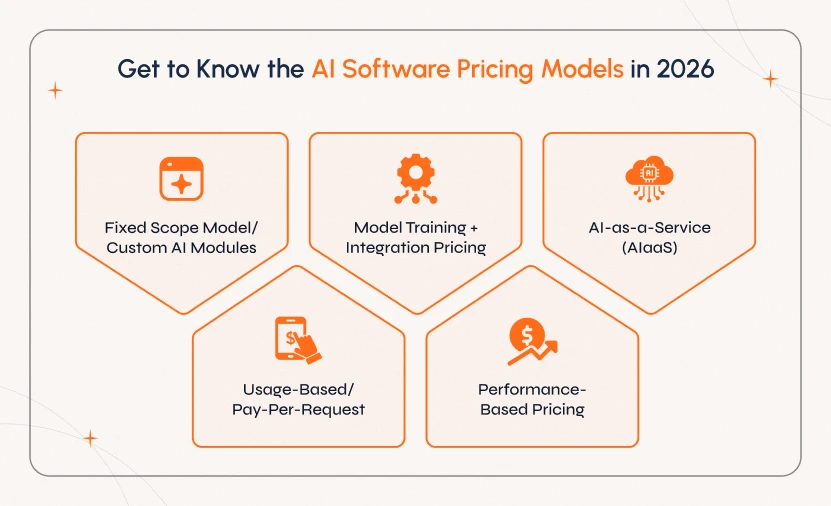
Best For: NLP Chatbots, Computer Vision Apps, and clearly scoped AI features.
In this model, you pay a flat fee for predefined models, making it ideal for custom AI software development with minimal uncertainty.
Best For: Projects using pre-trained LLMs or requiring fine-tuning like OpenAI, Claude, or Mistral.
Opting for this model means you are charged separately for model development (training/tuning) and system integration. This is the most common model for enterprise AI software.
Best For: Enterprises looking for frequent updates, API access, and scalability.
It is a subscription-based AI pricing model, and this includes access to hosted models like the OpenAI API, updates, SLAs, and support.
Best For: Generative AI apps, LLM APIs, and real-time inference systems.
You will pay based on the number of model calls, GPU hours, or data processed. This model closely aligns with AI software pricing trends in cloud-native deployments.
Best For: AI used in business-critical systems like fraud detection, recommendation engines, etc.
In this model, the costs are tied to model accuracy, uptime, and measurable business results. It greatly aligns incentives between the clients and vendors.
Is AI Software Development Worth the Cost? - Understanding the ROI
The AI software development cost may seem high upfront for many. However, the long-term return on investment (ROI) outweighs the initial expenses when the AI solution aligns with your business goals.
The benefits of AI software, when implemented strategically, include:
- Enhanced productivity through business automation
- Actionable, predictive business insights
- Improved customer experiences and engagement
- Competitive advantage during dynamic market shifts
For instance, a custom AI chatbot development cost in 2026 is calculated as follows: Firms can build for $40,000 could automate $1,000+ support hours annually, which is equal to over $70,000 in manual labour savings. This is the immediate ROI gain in the first year for the business.
Thus, by focusing on effective ways to develop AI software that targets high-impact areas, businesses can maximize returns and ensure their AI investment offers long-term success.
AI Vs Traditional Software Development Cost
Upon comparing AI in software engineering to traditional development, it is clear that AI solutions hold more complexity and higher development costs. On the other hand, they come with dynamic data-driven capabilities that traditional software development cannot offer.
| Aspect | Traditional Software | AI Software |
|---|---|---|
| Development Cost | Lower upfront | Higher due to R&D, model training |
| Data Dependency | $Minimal | Core to system functionality |
| Predictability | High (code-driven logic) | Variable & outcomes depend on data/model |
| Maintenance | Basic updates and bug fixes | Ongoing model tuning, retraining, and MLOps |
AI systems need continuous optimization, data updates, and model monitoring, so the AI vs traditional software development cost comparison is less about upfront budget and more about long-term value and adaptability.
Discover What Impacts AI Software Costs & How to Maximize ROI With Smarter Development
AI Software Pricing Trends to Watch in 2026
As AI development keeps increasing, pricing strategies are shifting to reflect new tools, platforms, and market demands. Get to know the top AI software pricing trends shaping 2026:
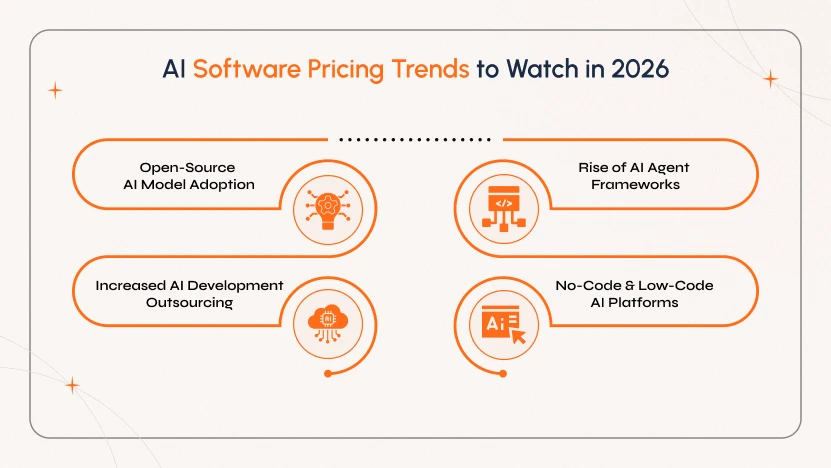
Companies are reducing dependency on costly proprietary systems with models like Mistral, LLaMA, and Falcon. This lowers entry barriers and impacts AI software pricing across industries.
Modular, reusable AI agent architectures are cutting development time and cost. These frameworks enable scalable solutions while optimizing resource usage, which is a growing AI software trend.
Tools like AutoML, Pinecone, and no-code builders help non-technical teams build AI prototypes quickly. This minimizes the need for companies to rely on full-stack AI teams and shifts AI pricing models towards accessibility.
More and more businesses are turning to AI-specialized outsourcing firms to gain access to niche expertise at lower costs. This trend is driving competitive AI development outsourcing rates in different parts of the world.
How to Save on AI Development Cost Without Compromising Quality
If you are wondering how much the AI development cost is and how to save, it can be achieved through smart planning. It helps reduce expenses while maintaining high quality. The proven strategies to optimize your budget for AI software development are as follows:
Instead of training from scratch, you can use powerful models like Gemini, GPT-4, Claude, or DeepSeek. This reduces R&D costs while speeding up time-to-market.
Consider hiring a seasoned team, as it helps with faster deployment, fewer revisions, and better architecture decisions. This, in turn, saves both time and money without compromising the performance of the AI software.
You can start by building a lean version of your AI solution focused on a single use case. MVPs are the best way to validate ideas early and, in turn, help control the cost of AI development before scaling.
By using platforms like AWS SageMaker, Vertex AI, and Azure AI, you can eliminate the need for expensive on-prem infrastructure. You can pay as you scale, which optimizes your AI software development budget.
Why Choose Sparkout for AI Software Development?
AI software development is all about building smart solutions that are efficient, scalable, and cost-effective. At Sparkout Tech, we combine deep AI expertise with a value-driven approach to ensure businesses receive the maximum return on AI investment. Here is why Sparkout is the right AI development partner:
1. We deliver high-performance AI software at competitive rates by using open-source and pre-trained models. We build reusable agent frameworks and deploy a modular architecture that scales without rework.
2. We build custom AI solutions tailored to your business needs, budget constraints, and ROI goals. There is no off-the-shelf AI when you partner with us.
3. From model training and LLM integration to cloud deployment, we offer end-to-end services with long-term support. This includes NLP & computer vision, predictive analysis, AI chatbots & autonomous agents, and enterprise AI apps for all domains.
4. Whether you are an enterprise scaling AI across departments or a startup prototyping an MVP, we offer flexible engagement models such as fixed-cost projects, agile sprint-based billing, and dedicated AI development teams.
5. We follow GDPR-compliant development practices, conduct regular model performance audits, and provide scalable hosting on AWS, Azure, or GCP. We ensure data privacy at every layer of the pipeline.
Get custom-built AI software with cost-efficiency, scalability & faster time-to-value.




